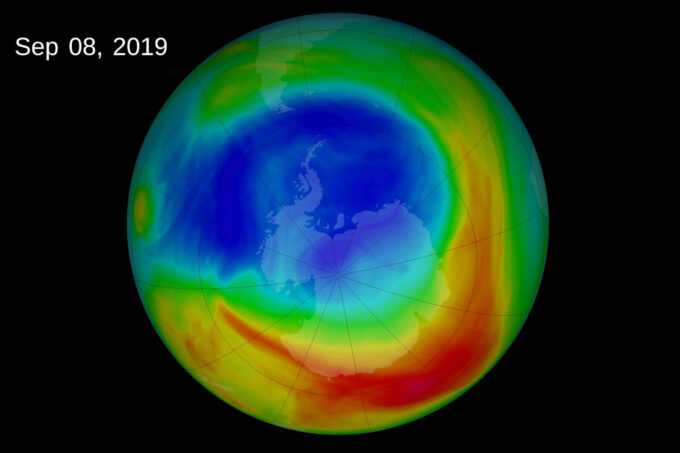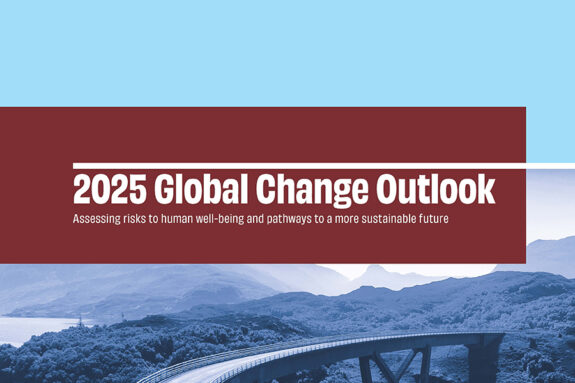3 Questions: Susan Solomon on plugging holes in ozone-layer and climate policies

The Montreal Protocol has dramatically curtailed emissions of ozone-depleting chemicals worldwide. The Antarctic ozone hole is recovering as a result, and lowering these emissions has also staved off substantial global warming. But the Protocol still has troubling loopholes.
The hole in the Antarctic ozone layer may be shrinking, but we’re not off the hook yet.
The Montreal Protocol of 1987 is a landmark achievement in global environmental policy, and represents widespread, science-backed cooperation with industry. This international treaty phased out the production and use of ozone-depleting compounds, of which the most well-known were chlorofluorocarbons (CFCs) used in refrigeration, as spray can propellants, and in insulating foams. Substitutes for the CFCs were found in all of these applications, and as a result of this stringent regulation, the ozone layer is now recovering. This reversal also has positive effects for human health: by the end of this century, the Montreal Protocol will have averted approximately 250 million cases of skin cancer and 50 million cases of cataracts. And in limiting emissions of ozone-depleting substances that double as potent greenhouse gases, the Montreal Protocol also protects against global warming. By 2010, it had averted about 15 gigatons of equivalent CO2 emissions per year.
But the Montreal Protocol isn’t watertight. In an invited Nature Communications article, MIT Lee and Geraldine Martin Professor of Environmental Studies Susan Solomon and her colleagues explain the gaps. Solomon is one of the atmospheric chemists who determined the cause of the Antarctic ozone hole, and whose work helped push through the Montreal Protocol. Solomon is both heartened by the Montreal Protocol’s achievements, and keenly aware that global policy must now evolve to stave off further ozone depletion and the damaging consequences of a global temperature increase of 1.5°C.
This month marks the 35th anniversary of the Montreal Protocol. As Solomon describes, the policy has been effective — but there are gaps in it that cause unnecessary damage to the ozone and the climate, and it’s time to address them.
Q: To date, how has the Montreal Protocol affected global emissions of ozone-depleting substances and greenhouse gases?
A: We’ve been able to phase out 98% of the CFCs targeted in the Montreal Protocol – It has been hailed for many years as the most successful environmental protocol that’s ever been. This is a remarkable, remarkable success, because the environmental problem was personal with the potential health effects, perceptible with the Antarctic ozone hole, and had practical solutions. And it’s been possible only through global cooperation: the Vienna Convention of 1985 and the subsequent Montreal Protocol of 1987 are ratified by 197 parties from around the world. So far, these are the only treaties — environmental or otherwise — to be accepted by every United Nations state.
Although ozone depletion and global warming are two different problems, the atmospheric gases involved make these issues intertwined. Many ozone-depleting compounds are also greenhouse gases that contribute to global warming. This is the case for CFCs, which have atmospheric lifetimes of some 50 to 500 years. This means that phasing out CFCs under the Montreal Protocol has also helped combat climate change – in fact, it has saved something like five times more carbon equivalent than the Kyoto Protocol. It’s also significant compared to what’s going on now with the Paris Agreement. So, even though the Montreal Protocol is aimed at helping the ozone layer, it happens to be by far the most effective move against global warming we have made so far.
But we do have some issues that we really need to pay attention to, if the history of the Montreal Protocol for the 21st century is going to match the achievements that it had in the 20th century.
Q: What threats do the ozone layer and climate still face today, and how severe are they?
A: The Montreal Protocol successfully limits how many new CFCs are produced and sold between countries. But from the early- to mid-2010s, there was been about a 30% increase in CFC-11 and a slow decrease in other CFCs, indicating new production that violates the agreement. Additionally, the Montreal Protocol doesn’t address CFC “banks” — collections of old CFCs in things such as air conditioners and insulating foams from the 1970s and 1980s. When foams degrade or cooling units start leaking, those CFCs go into the atmosphere. These emissions are largely unnecessary, because CFCs are relatively easy to dispose of. For example, we can reduce them if we round up the harmful material in CFC foam banks during building demolition, bury it in landfills, and let the microbes get to work. Japan is successfully destroying much of its CFC foam banks in this way. We have to follow suit on a global scale and start disposing of CFC banks around the world. Otherwise, the amount that could reach the atmosphere from these leaking CFC banks is about 10 gigatons of CO2 equivalent over the next century – an amount, if recovered, would do more for the climate system than the European Union’s current pledge under the Paris Agreement.
Another major issue is chemical feedstocks. These are chemicals used to produce other compounds for industry. The Montreal Protocol doesn’t regulate feedstocks made up of ozone-depleting CFCs; the belief was that these harmful gases would be destroyed while manufacturing the desired end product. But in fact, some of these CFC feedstocks are leaking significantly: carbon tetrachloride makes up like 15 gigagrams per year or about 0.3 gigatons of CO2 equivalent per decade, and CFC-113 is about 0.4 gigatons of CO2 equivalent per decade. There are other gases CFC-115 and CFC-114 that also seem to be leaking, and that adds up. This is not only a waste of material for the companies, but a serious source of emissions that harm the ozone layer. Luckily, companies working with these feedstocks have developed ways to minimize this kind of leakage. We just need to put this into practice systematically.
One of the last uncontrolled ozone depleting gases is N2O, nitrous oxide, which is a strong greenhouse gas. It’s been a hot button issue for a long time in terms of cost because it’s produced as an unwanted byproduct of fertilization in agriculture, but there’s evidence that emissions can be cut in a cost-effective manner.
Unexpectedly high emissions of a hydrofluorocarbon (HFC) called HFC-23 is another issue that we can and should deal with. As CFCs were phased out, we started using hydrochlorofluorocarbons (HCFCs) instead, and later hydrofluorocarbons (HFCs). These HFCs don’t deplete as much ozone, but both are still strong greenhouse gases. The Kigali Amendment to the Montreal Protocol regulates many of the HFCs, but HFC-23 is one compound that’s not controlled under that treaty. Now, HFC-23 emissions are threatening to overwhelm the accomplishments of the Kigali Amendment.
We need to tackle leaky CFC feedstocks and CFC banks, and regulate HFC-23 emissions. These are undermining decades of otherwise unbelievably successful global effort — and not finishing the job would be a tragic waste.
Q: Earlier this month, U.S. senators from both sides of the aisle came together to support HFC regulation in the U.S. What can we gain by working collaboratively now?
A: Ozone-layer science and policy achievements of the past few decades really shine a spotlight on just how much we can get done by working together. In the 1970s, the worse-case scenario under discussion was that CFCs might deplete the ozone layer by a few percent over the next hundred years. The problem turned out to be much worse, but even this idea already had people worried enough to start making changes. Consumers turned away from spray cans in droves — at that time, aerosol spray cans were responsible for about two-thirds of all CFC use in the United States. We also realized we could use less harmful propellants in spray cans, and reduce CFCs that way, so spray cans today are perfectly safe for the ozone layer. These were simple fixes, but they had a huge benefit.
And in the mid-1980s, the discovery of the Antarctic ozone hole prompted truly global collaboration. With so many countries working together under the Montreal Protocol, we not only slowed down damage to the ozone layer, but we actually managed to reverse it.
The Senate’s recent bipartisan bill to limit domestic HFC use is real step forward, one that I hope will also lead to the U.S. ratifying the Kigali Amendment. We’re at a point where we need to do more, or jeopardize all our progress. Fortunately, we already have all the necessary experience and tools. We have all the ways — now we just need the will.
This research has been funded, in part, by the VoLo Foundation and by the Martin Chair in Environmental Studies at MIT.
Story Image: The 2019 ozone hole reached its peak extent of 6.3 million square miles (16. 4 million square kilometers) on Sept. 8. Abnormal weather patterns in the upper atmosphere over Antarctica dramatically limited ozone depletion this year. Credit: NASA


